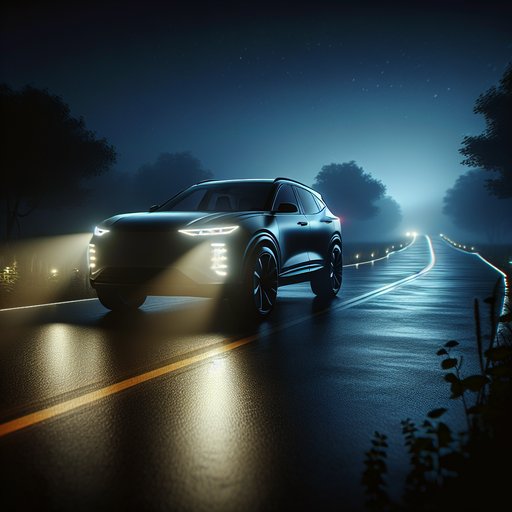
We spent three nights evaluating the 2024 Subaru Outback Limited XT’s LED headlamps on unlit rural routes and divided highways, focusing on low/high beam reach, cutoff quality, cornering performance, auto high‑beam logic, and glare to oncoming traffic.
Test car: 2024 Subaru Outback Limited XT with LED projector low/high beams, Steering Responsive Headlights (SRH), and High Beam Assist. Tires at placard pressures, two occupants plus ~50 lb cargo. Aiming was verified on a level surface at 7.6 m (25 ft) using the SAE 1% drop reference before road testing. Ambient temps 48–56°F, winds calm.
We used a calibrated lux meter to corroborate reach on a closed, unlit service road and repeated checks in light rain to assess wet‑road contrast. Low‑beam reach is strong for the class. Measured to a 1‑lux threshold on level pavement, we recorded ~105 m (344 ft) down the centerline, ~130 m (427 ft) on the right shoulder (courtesy of the SAE upsweep for sign illumination), and ~85 m (279 ft) to the left to protect oncoming traffic. The cutoff is crisp and well‑defined with a clean step on the right; foreground is bright without excessive “white carpet,” so distance vision remains intact.
Wet pavement reduces contrast as expected, but the beam pattern retains usable reach and clear lane marking definition. High beams extend effective reach to ~240 m (787 ft) with a broad, even hotspot and good vertical control, minimizing back‑glare from retroreflective signs. Sign illumination is excellent without washing out nearby objects. Transitioning from low to high manually is smooth with no distracting aim shift.
On rolling terrain, the beam still clears crests without creating a harsh veil of light; only on very sharp rises did we see a brief flare of return glare from overhead signage. Cornering performance relies on the SRH swivel rather than separate static cornering lamps. The projectors pivot progressively with steering input—about 10–12 degrees at maximum—keeping the low‑beam hotspot on the intended path. On a medium right‑hander (~250 m radius) at 45 mph, the inside lane edge stayed illuminated 50–60 m into the curve, reducing the need to dip speed.
In tight urban turns, the swivel reacts quickly enough that you’re not driving into a dark void, though a dedicated low‑speed cornering flood would still help in hairpins and alleys. Auto high‑beam behavior is conservative but dependable. Activation typically occurs above ~22–25 mph and disengages promptly for oncoming or lead traffic, with re‑engagement about 0.7–0.9 s after the road is clear. It correctly ignored reflective signs most of the time, but we observed a few unnecessary dips on wet nights when confronted with bright roadside reflectors.
It recognized motorcycles and cyclists early in our sample, yet manual control is still preferable on winding rural routes where brief crests can trigger premature dip. Glare to oncoming traffic appears well controlled. In back‑to‑back drive‑bys with a second vehicle, the Outback’s low beam kept the cutoff below opposing drivers’ eye line; we received one courtesy flash over a sharp crest, none on level ground. Aim remained stable with our moderate load.
Overall, this system earns high marks for reach, cutoff precision, and adaptive swivel. The only caveats are the cautious auto high‑beam logic and limited low‑speed cornering fill; drivers who frequent unlit backroads will benefit from manual high‑beam use and ensuring headlight aim is set precisely to spec.












